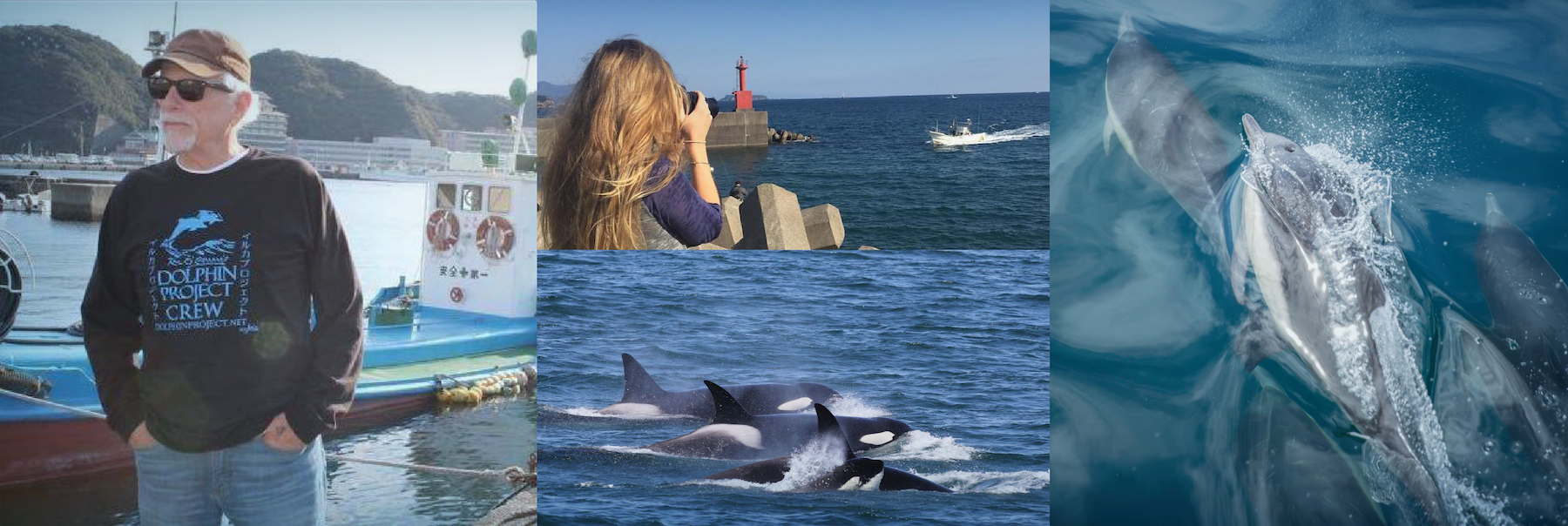Dolphin Outlook Weekly update from #TheCove, Taiji, Japan, Week of Blue Cove days, Killing of many blood of striped dolphins This Week, 2017/2018 Quota (2047 Total), Up to Date Season Killing & Capturing Stats, Galveston Bay & a Message from Ric O'Barry
After a week of Blue Cove days, the Cove now runs red with the blood of striped dolphins.


Weekly update from #TheCove: First striped dolphins slaughtered & another pod of melon-headed whales decimated in Week #15 of Taiji’s hunts.







The weather was calm this morning when Cove Monitors noticed the banger boats in drive formation. And just like last week’s striped drive, the hunters completely terrorized these dolphins: revving their engines, banging their poles, throwing lead weights at them, taking them at least two hours to drive them towards the Cove. Even though the pod seemed absolutely exhausted, they still made every attempt to escape, but the hunters mercilessly persisted. After being netted into the Cove, the pod clung together tightly in their last moments as a family, before being driven under the tarps to their deaths. Cove Monitors could hear the struggle of the dolphins as they thrashed in the water. This went on for several minutes, before the water was then saturated with blood. Two skiffs soon emerged with the bodies, hidden by tarps and disrespectfully sat on by the hunters. 15 striped dolphins who were swimming wild and free only hours ago, were brutally murdered this morning, now to be sold as meat for human consumption. 12-15-17 3:40pm #dolphinproject Be a voice for the voiceless:
TAKE ACTION: dolphin.fyi/HelpJapanDolphins
Week of Blue Cove days in Taiji, Japan!

Many have lesions covering their sleek, grey bodies. Others are malnourished. A large number have simply disappeared from once-productive fishing grounds.
Researchers are seeking to understand what has affected the previously thriving dolphin populations and their best chances for a full recovery, but it's undeniable that petro-chemical companies spilled massive amounts of pollution into the Houston Ship Channel and into Galveston Bay in the wake of Hurricane Harvey. Those toxic chemicals aren't good for dolphins, or the fish they rely upon.
Valero Energy, ExxonMobil and Arkema - 3 companies that released significant amounts of pollution during Harvey, need to take responsibility for their actions and create a dolphin research and recovery fund.
While the nation moves on to the next disaster, these dolphins are still fighting to recover. We can't forget them, and we must support the researchers working to restore their health and habitat. Help hold these large polluters accountable!
| A Message from Ric O'Barry |
| It’s hard to believe
2017 is coming to a close, yet I have never felt more positive about the
progress we’ve made for dolphins as I do now. We’ve gained tremendous momentum
worldwide as people across the globe are realizing that dolphins do not belong
in captivity, nor should they be hunted, abused or slaughtered. The three most
difficult places on Earth to work on behalf of dolphins are Japan, Indonesia and
the Solomon Islands – in fact, we are the only organization on the ground in
those places and will remain there as long as dolphins are in need. Indonesia’s horrific traveling dolphin circuses. Credit: DolphinProject.com Successes from this year include: • Dolphin Project has long advocated dolphin sanctuaries to retire captive dolphins, and we are continuing to move forward with plans for Europe’s first dolphin sanctuary project. This year I had the opportunity to scout various locations in Italy and Greece as we continue efforts to make this project a reality. • Lincoln O’Barry and Dr. Sarah Meltzoff returned to Fanalei in the Solomon Islands to continue our work in helping dolphin-hunting communities transition away from their conventional hunts. Home to the largest drive slaughter of dolphins in the world, annual kills have dropped from a yearly average of 850 to 110 in 2016. We are currently building a permanent field base in Fanalei, which will allow us to continue working with the community to develop sustainable economic alternatives to dolphin-hunting and strengthen marine protection in the area. • In Indonesia, we are continuing our efforts to end dolphin abuse, including putting an end to the traveling dolphin circuses, dolphin-swim programs and renovating Camp Lumba Lumba, the world’s first permanent rehabilitation facility for captive dolphins. Dolphin Project established an education center in Flores, where islanders and tourists alike can learn about the importance of protecting marine life. It is the first center of its kind in Flores, an area known for marine mammal and sea turtle poaching. • Dolphin Project returned to The Cove in Taiji, Japan, for its 15th season, where our team is on the ground for the entire six-month hunting season. Using live-streaming technology and – new this year – 360-degree “immersive” video to document the dolphin drive hunts, we remain committed to sharing this information with the world. The season launched on Japan Dolphins Day, an international day of action and awareness that we have coordinated since 2005. Earlier this year, Dolphin Project Celebrity Ambassador and Game of Thrones star Maisie Williams traveled to Taiji in support of our campaign. Camp LumbaLumba, the world’s first permanent rehabilitation facility for rescued dolphins, Indonesia. Credit: DolphinProject.com We’ve come a long way since 1970 when I made it my life’s mission to protect dolphins worldwide from exploitation and slaughter. Now, 47 years later, all of us at Dolphin Project are as committed as ever to making real and positive change for dolphins, but we need you on our team. We are entirely funded by you. Each time you donate to Dolphin Project, know that you are aiding the longest-running anti-captivity dolphin welfare organization in the world. Thank you for your support and for being on the right side of history. Ric O’Barry, Founder/Director Dolphin Project |
Your Help Has Never Been More
Needed
|




 Ric O’Barry, Founder/Director
Ric O’Barry, Founder/Director













